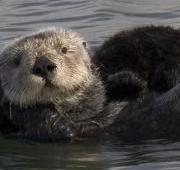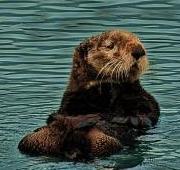 The sea otter is a small marine mammal native to the north and eastern coasts of the Pacific Ocean. Despite the fact that sea otters are the largest members of the weasel family, sea otters are among the smallest mammals in the marine world.
The sea otter is a small marine mammal native to the north and eastern coasts of the Pacific Ocean. Despite the fact that sea otters are the largest members of the weasel family, sea otters are among the smallest mammals in the marine world. The sea otter is known to have one of the thickest, warmest coats of fur in the animal kingdom which helps to keep the sea otter warm in the cold waters of the North Pacific. Like their smaller river otter cousins, the sea otter is able to walk and live on the land but it is not uncommon for sea otters to spend their lives exclusively in the water.
The sea otter is known to have one of the thickest, warmest coats of fur in the animal kingdom which helps to keep the sea otter warm in the cold waters of the North Pacific. Like their smaller river otter cousins, the sea otter is able to walk and live on the land but it is not uncommon for sea otters to spend their lives exclusively in the water.


Sea otters are today considered to be an endangered species are they were extensively hunted for their fur in the 18th century which meant that sea otter populations took a devastating plunge and sea otters became rarer and rarer. There are estimated to be less than 2,000 sea otter individuals left in the wild today.
There are three different species of sea otter that are recognised by science today. The common sea otter (also known as the Asian sea otter) is the largest of the tree sea otter subspecies and is found around the islands in the Western Pacific. The southern sea otter (also known as the Californian sea otter) is found off the coast of California and is known to have a narrow head and small teeth. The northern sea otter is native to Alaska and the North West of the Pacific. The northern sea otter was wiped out from the coast of British Columbia due to over hunting but has been recently reintroduced to Vancouver Island.
Unlike other marine mammals, the sea otter does not have a layer of blubber to keep it warm, so the sea otter has to rely on it's dense fur to keep the cold out. The fur of the sea otter is so thick that no water actually touches the skin of the sea otter. The sea otter's fur also consists of two layers, a waterproof layer of long guard hairs with a layer of short thick fur underneath.
Although sea otter hunt and forage for food on their own, sea otters are often seen resting together in large single-sex groups known as rafts. Typically, the average sea otter raft consists of between 10 to 100 sea otter individuals, with the largest recorded sea otter raft containing nearly 2,000 sea otter individuals.
Sea otters are known to mate all year round, but the southern sea otter is known to mate every year, which is twice as often as the northern sea otter. After a gestation period of up to a year, the mother sea otter gives birth to a single sea otter although twins are known to occur. Mother sea otters are known to nurse their pups for up to a year, by which time, the sea otter pups are able to hunt and forage for food by themselves.

